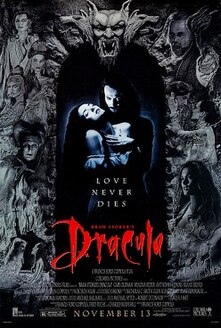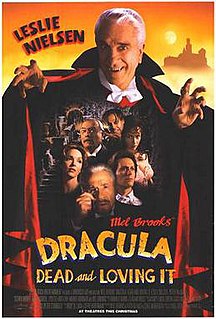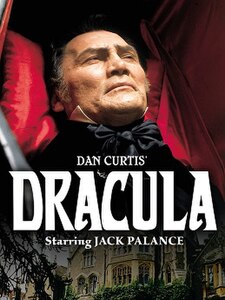Related Research Articles

Dracula is a novel by Bram Stoker, published in 1897. As an epistolary novel, the narrative is related through letters, diary entries, and newspaper articles. It has no single protagonist, but opens with solicitor Jonathan Harker taking a business trip to stay at the castle of a Transylvanian noble, Count Dracula. Harker escapes the castle after discovering that Dracula is a vampire, and the Count moves to England and plagues the seaside town of Whitby. A small group, led by Abraham Van Helsing, hunt Dracula and, in the end, kill him.

Vampire literature covers the spectrum of literary work concerned principally with the subject of vampires. The literary vampire first appeared in 18th-century poetry, before becoming one of the stock figures of gothic fiction with the publication of Polidori's The Vampyre (1819), which was inspired by the life and legend of Lord Byron. Later influential works include the penny dreadful Varney the Vampire (1847); Sheridan Le Fanu's tale of a lesbian vampire, Carmilla (1872), and the most well known: Bram Stoker's Dracula (1897). Some authors created a more "sympathetic vampire", with Varney being the first, and Anne Rice's 1976 novel Interview with the Vampire as a more recent example.

Bram Stoker's Dracula is a 1992 American Gothic horror film directed and produced by Francis Ford Coppola, based on the 1897 novel Dracula by Bram Stoker. It stars Gary Oldman as Count Dracula, Winona Ryder as Mina Harker, Anthony Hopkins as Professor Abraham Van Helsing, and Keanu Reeves as Jonathan Harker.

Professor Abraham Van Helsing, a fictional character from the 1897 gothic horror novel Dracula, is an aged polymath Dutch doctor with a wide range of interests and accomplishments, partly attested by the string of letters that follows his name: "MD, D.Ph., D.Litt., etc.", indicating a wealth of experience, education and expertise. The character is best known through many adaptations of the story as a vampire hunter and the archenemy of Count Dracula, and the prototypical and the archetypical parapsychologist in subsequent works of paranormal fiction.

Dracula: Dead and Loving It is a 1995 gothic comedy horror film directed by Mel Brooks and starring Leslie Nielsen. It is a spoof of Bram Stoker's novel Dracula and of some of the films it spawned.

Dracula is a 1958 British gothic horror film directed by Terence Fisher and written by Jimmy Sangster based on Bram Stoker's 1897 novel of the same title. The first in the series of Hammer Horror films starring Christopher Lee as Count Dracula, the film also features Peter Cushing as Doctor Van Helsing, along with Michael Gough, Melissa Stribling, Carol Marsh, and John Van Eyssen. In the United States, the film was retitled Horror of Dracula to avoid confusion with the U.S. original by Universal Pictures, 1931's Dracula.

Dracula is a 1931 American pre-Code supernatural horror film directed and co-produced by Tod Browning from a screenplay written by Garrett Fort. It is based on the 1924 stage play Dracula by Hamilton Deane and John L. Balderston, which in turn is adapted from the 1897 novel Dracula by Bram Stoker. The film stars Bela Lugosi as Count Dracula, a vampire who emigrates from Transylvania to England and preys upon the blood of living victims, including a young man's fiancée.

Dracula is a 1979 British-American horror film directed by John Badham. The film starred Frank Langella in the title role as well as Laurence Olivier, Donald Pleasence and Kate Nelligan.
Patricia Nead Elrod is an American novelist specializing in urban fantasy. She has written in the mystery, romance, paranormal, and historical genres with at least one foray into comedic fantasy. Elrod is also an editor, having worked on several collections for Ace Science Fiction, DAW, Benbella Books, and St. Martin's Griffin. She self-published a signed, limited edition novel under her own imprint, Vampwriter Books.
Wilhelmina "Mina" Harker is a fictional character and the main female character in Bram Stoker's 1897 Gothic horror novel Dracula.

Quincey P. Morris is a fictional character in Bram Stoker's 1897 horror novel Dracula.

Vampire films have been a staple in world cinema since the era of silent films, so much so that the depiction of vampires in popular culture is strongly based upon their depiction in films throughout the years. The most popular cinematic adaptation of vampire fiction has been from Bram Stoker's 1897 novel Dracula, with over 170 versions to date. Running a distant second are adaptations of the 1872 novel Carmilla by Sheridan Le Fanu. By 2005, the Dracula character had been the subject of more films than any other fictional character except Sherlock Holmes.

The Brides of Dracula are characters in Bram Stoker's 1897 novel Dracula. They are three seductive female vampire "sisters" who reside with Count Dracula in his castle in Transylvania, where they entrance men with their beauty and charm, and then proceed to feed upon them. Dracula provides them with victims to devour, mainly implied to be infants.

The Historian is the 2005 debut novel of American author Elizabeth Kostova. The plot blends the history and folklore of Vlad Țepeș and his fictional equivalent Count Dracula. Kostova's father told her stories about Dracula when she was a child, and later in life she was inspired to turn the experience into a novel. She worked on the book for ten years and then sold it within a few months to Little, Brown and Company, which bought it for US$2 million.
Karen E. Taylor is the author of The Vampire Legacy Series of novels, published by Kensington Books. A voracious reader of vampire/horror novels, Karen first started writing Blood Secrets in January, 1988. She conceived of writing the novel while living across the street from a very large cemetery. It was never intended to be the first book of an ongoing series, but fans who had read the novel demanded a sequel. To date, the series stands at seven titles, and has earned a cult following. Her short stories have appeared in numerous anthologies, including: Love Bites, 100 Vicious Little Vampires, 100 Wicked Little Witches, A Horror Story A Day, and Seductive Spectres. In 2001, she was nominated for the Bram Stoker Award for best short story for "Mexican Moon".

Count Dracula is the title character of Bram Stoker's 1897 gothic horror novel Dracula. He is considered to be both the prototypical and the archetypal vampire in subsequent works of fiction. Some aspects of the character are believed to have been inspired by the 15th-century Wallachian Prince Vlad the Impaler, who was also known as Dracula, and by Sir Henry Irving, an actor for whom Stoker was a personal assistant.

Dracula, also known as Bram Stoker's Dracula and Dan Curtis' Dracula, is a 1974 British made-for-television gothic film horror film and adaptation of Bram Stoker's 1897 novel Dracula. It was written by Richard Matheson and directed by Dark Shadows creator Dan Curtis, with Jack Palance in the title role. It was the second collaboration for Curtis and Palance after the 1968 TV film The Strange Case of Dr. Jekyll and Mr. Hyde.
The character of Count Dracula from the 1897 novel Dracula by Bram Stoker, has remained popular over the years, and many films have used the Count as a villain, while others have named him in their titles, such as Dracula's Daughter, The Brides of Dracula, and Dracula's Dog. Dracula has enjoyed enormous popularity since its publication and has spawned an extraordinary vampire subculture in the second half of the 20th century. More than 200 films have been made that feature Count Dracula, a number second only to Sherlock Holmes. At the center of this subculture is the legend of Transylvania, which has become almost synonymous with vampires.

Tapestry of Dark Souls is a fantasy horror novel by Elaine Bergstrom, set in the world of Ravenloft, and based on the Dungeons & Dragons game. It was published by TSR, Inc.

Dracula the Un-dead is a 2009 sequel to Bram Stoker's classic 1897 novel Dracula. The book was written by Bram Stoker's great-grandnephew Dacre Stoker and Ian Holt. Previously, Holt had been a direct-to-DVD horror screenwriter, and Stoker a track and field coach.
References
- 1 2 3 4 5 6 7 8 Loohauis, Jackie (October 24, 2004). "Bergstrom has insatiable thirst for her next vampire kill", Milwaukee Journal Sentinel . Convenience link Archived 2014-05-17 at the Wayback Machine (registration required).
- ↑ Sandstrom, Karen (November 2, 1994). "At the end, blind, entranced, I felt only", The Plain Dealer , p. 9B.
- 1 2 3 "Elaine Bergstrom". Archived from the original on February 24, 2009.
- ↑ Strassmeyer, Mary (July 5, 1989). "Shattered Glass", The Plain Dealer .
- ↑ "Pen & Paper listing for Elaine Bergstrom". Archived from the original on 2004-12-28.